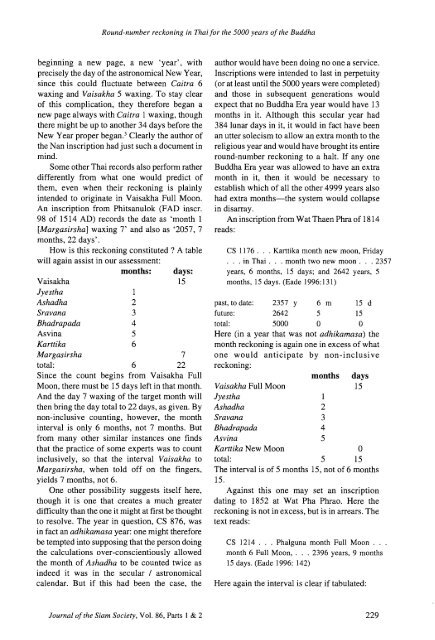The Journal of the Siam Society Vol. LXXXVI, Part 1-2 ... - Khamkoo
The Journal of the Siam Society Vol. LXXXVI, Part 1-2 ... - Khamkoo
The Journal of the Siam Society Vol. LXXXVI, Part 1-2 ... - Khamkoo
You also want an ePaper? Increase the reach of your titles
YUMPU automatically turns print PDFs into web optimized ePapers that Google loves.
Round-number reckoning in Thai for <strong>the</strong> 5000 years <strong>of</strong> <strong>the</strong> Buddha<br />
beginning a new page, a new 'year', with<br />
precisely <strong>the</strong> day <strong>of</strong> <strong>the</strong> astronomical New Year,<br />
since this could fluctuate between Caitra 6<br />
waxing and Vaisakha 5 waxing. To stay clear<br />
<strong>of</strong> this complication, <strong>the</strong>y <strong>the</strong>refore began a<br />
new page always with Caitra 1 waxing, though<br />
<strong>the</strong>re might be up to ano<strong>the</strong>r 34 days before <strong>the</strong><br />
New Year proper began. 3 Clearly <strong>the</strong> author <strong>of</strong><br />
<strong>the</strong> Nan inscription had just such a document in<br />
mind.<br />
Some o<strong>the</strong>r Thai records also perform ra<strong>the</strong>r<br />
differently from what one would predict <strong>of</strong><br />
<strong>the</strong>m, even when <strong>the</strong>ir reckoning is plainly<br />
intended to originate in V aisakha Full Moon.<br />
An inscription from Phitsanulok (FAD inscr.<br />
98 <strong>of</strong> 1514 AD) records <strong>the</strong> date as 'month 1<br />
[Margasirsha] waxing 7' and also as '2057, 7<br />
months, 22 days'.<br />
How is this reckoning constituted ? A table<br />
will again assist in our assessment:<br />
months:<br />
Vaisakha<br />
Jyestha<br />
Ashadha<br />
Sravana<br />
Bhadrapada<br />
Asvina<br />
Karttika<br />
Margasirsha<br />
total:<br />
1<br />
2<br />
3<br />
4<br />
5<br />
6<br />
days:<br />
15<br />
7<br />
22<br />
6<br />
Since <strong>the</strong> count begins from Vaisakha Full<br />
Moon, <strong>the</strong>re must be 15 days left in that month.<br />
And <strong>the</strong> day 7 waxing <strong>of</strong> <strong>the</strong> target month will<br />
<strong>the</strong>n bring <strong>the</strong> day total to 22 days, as given. By<br />
non-inclusive counting, however, <strong>the</strong> month<br />
interval is only 6 months, not 7 months. But<br />
from many o<strong>the</strong>r similar instances one finds<br />
that <strong>the</strong> practice <strong>of</strong> some experts was to count<br />
inclusively, so that <strong>the</strong> interval Vaisakha to<br />
Margasirsha, when told <strong>of</strong>f on <strong>the</strong> fingers,<br />
yields 7 months, not 6.<br />
One o<strong>the</strong>r possibility suggests itself here,<br />
though it is one that creates a much greater<br />
difficulty than <strong>the</strong> one it might at first be thought<br />
to resolve. <strong>The</strong> year in question, CS 876, was<br />
in fact an adhikamasa year: one might <strong>the</strong>refore<br />
be tempted into supposing that <strong>the</strong> person doing<br />
<strong>the</strong> calculations over-conscientiously allowed<br />
<strong>the</strong> month <strong>of</strong> Ashadha to be counted twice as<br />
indeed it was in <strong>the</strong> secular I astronomical<br />
calendar. But if this had been <strong>the</strong> case, <strong>the</strong><br />
author would have been doing no one a service.<br />
Inscriptions were intended to last in perpetuity<br />
(or at least until <strong>the</strong> 5000 years were completed)<br />
and those in subsequent generations would<br />
expect that no Buddha Era year would have 13<br />
months in it. Although this secular year had<br />
384 lunar days in it, it would in fact have been<br />
an utter solecism to allow an extra month to <strong>the</strong><br />
religious year and would have brought its entire<br />
round-number reckoning to a halt. If any one<br />
Buddha Era year was allowed to have an extra<br />
month in it, <strong>the</strong>n it would be necessary to<br />
establish which <strong>of</strong> all <strong>the</strong> o<strong>the</strong>r 4999 years also<br />
had extra months-<strong>the</strong> system would collapse<br />
in disarray.<br />
An inscription from Wat Thaen Phra <strong>of</strong> 1814<br />
reads:<br />
CS 1176 . . . Karttika month new moon, Friday<br />
. . . in Thai . . . month two new moon . . . 2357<br />
years, 6 months, 15 days; and 2642 years, 5<br />
months, 15 days. (Eade 1996:131)<br />
past, to date: 2357 y 6 m 15 d<br />
future: 2642 5 15<br />
total: 5000 0 0<br />
Here (in a year that was not adhikamasa) <strong>the</strong><br />
month reckoning is again one in excess <strong>of</strong> what<br />
one would anticipate by non-inclusive<br />
reckoning:<br />
months days<br />
Vaisakha Full Moon 15<br />
Jyestha 1<br />
Ashadha 2<br />
Sravana 3<br />
Bhadrapada 4<br />
Asvina 5<br />
Karttika New Moon 0<br />
total: 5 15<br />
<strong>The</strong> interval is <strong>of</strong> 5 months 15, not <strong>of</strong> 6 months<br />
15.<br />
Against this one may set an inscription<br />
dating to 1852 at Wat Pha Phrao. Here <strong>the</strong><br />
reckoning is not in excess, but is in arrears. <strong>The</strong><br />
text reads:<br />
CS 1214 . . . Pha1guna month Full Moon . . .<br />
month 6 Full Moon, . . . 2396 years, 9 months<br />
15 days. (Eade 1996: 142)<br />
Here again <strong>the</strong> interval is clear if tabulated:<br />
<strong>Journal</strong> <strong>of</strong> <strong>the</strong> <strong>Siam</strong> <strong>Society</strong>, <strong>Vol</strong>. 86, <strong>Part</strong>s 1 & 2<br />
229

















